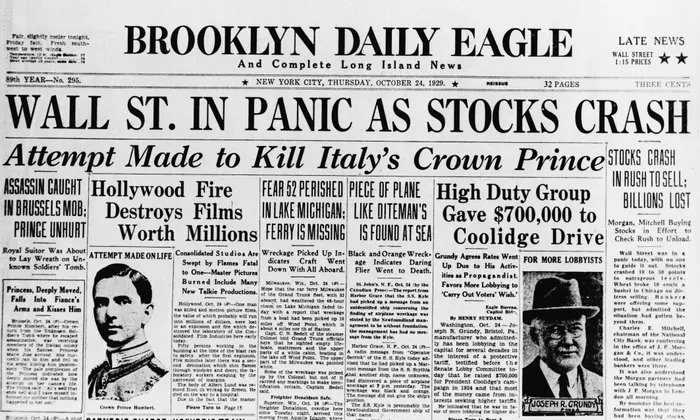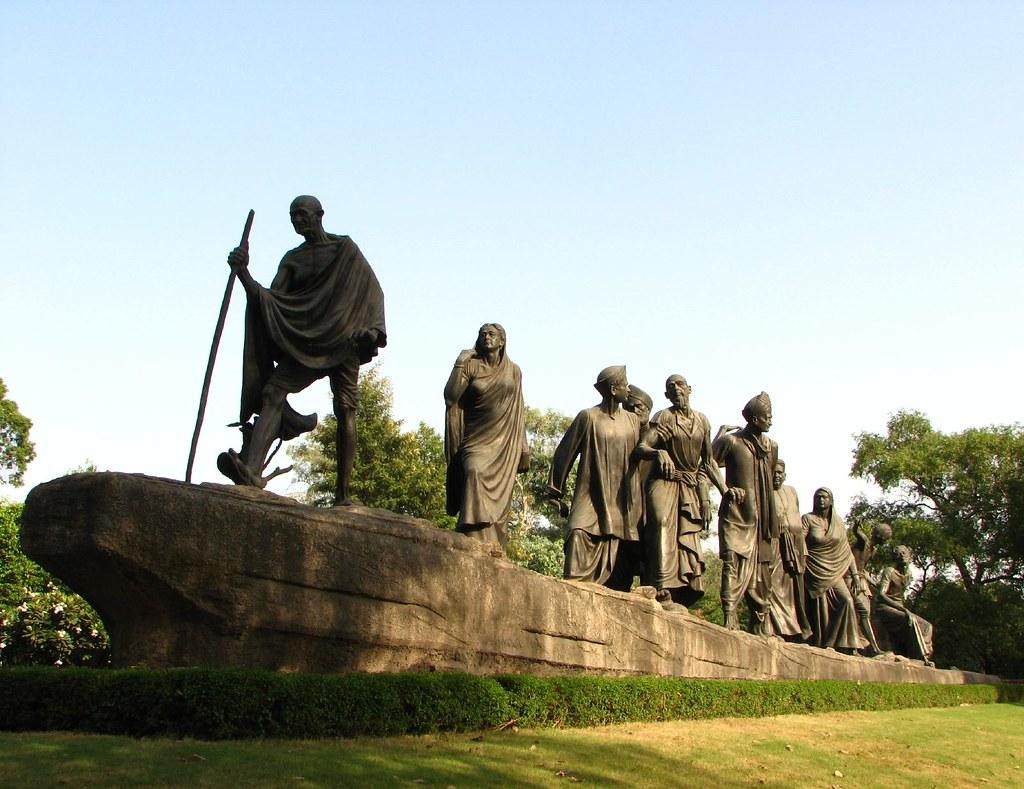The Great Depression (1929-39)
Blogs Home
- 29 Jul 2022

After working in his industry for almost two decades, Ashok gathered the courage to start his own enterprise. He was elated after getting a positive response to his business plan after initial talks with the investors. Everything was going as he planned but to Ashok’s dismay, the news of coronavirus spread hit the market and within a few months his venture, which took off smoothly, started feeling the heat. Like several businesses Ashok’s enterprise also struggled to survive and eventually had to shut its functions down. The Covid-19 pandemic has had an impact on economic indexes throughout the world. The global economy witnessed a downfall in the form of increased unemployment, reduction in demand, fall in production etc. after governments across the globe imposed mass lockdowns and people had to practice social distancing to contain the spread of the disease. Some signs of recovery were seen in between but with the ongoing Russia-Ukraine war the global economy once again was put in limbo. All economies of the world are facing decreasing growth opportunities and increasing inflation.
Similar unpleasant situations surfaced during 1929-39 when the entire world economy underwent unprecedented economic upheaval, historically known as the Great Depression. Some economists have started comparing the current global economic slowdown to the economic distress witnessed by the world during the great depression. We know the causes behind the current slowdown but the reasons that caused the great depression couldn’t be pinpointed till now. Still, it would be a good precautionary measure to understand how the great depression affected the world economy a century ago, and the lessons that it taught the human race.
Causes behind the Great Depression
An entire decade of economic uncertainty put a lot of people under tremendous pressure to survive which also resulted in mental and emotional turmoil for many. It was a shock for all the economies around the world, especially for the American economy which was revelling through a successful period driven by a bullish stock market.
Experts and frontrunners in the market were also not able to predict any formula to get out of the ditch. The weakening stock market of America, decrease in aggregate demand, agrarian crisis across the globe, overproduction, and inefficient policy decisions together caused the worst economic distress of the 20th century. It transformed the socio-political and economic order around the world forever.
Change in American Workforce
In the 18th century, America after attaining independence from England was largely agrarian but it underwent an enormous transformation with increasing industrial production. The expansive industrial revolution in America during the 19th century resulted in a huge change in the American workforce. The number of non-agricultural workers rose steadily after 1870. By 1930, out of every 5 Americans, only 1 remained an agricultural worker. In 1870 America was the second-largest industrial producer in the world with 23% of the world’s industrial production. By 1930, it acquired the first position in world industrial production being responsible for 42% of total world industrial production.
The World War I and The Roaring Twenties
The world in the second decade of the 20th century also underwent World War I (WWI). Many men were serving in the army, martyring, and returning as amputees. Women had to enter the workforce to make up for absent men.
The youth was disillusioned with the horrors of the war. Artists, writers, and intellectuals known as the Lost generation questioned the civilized world that could not manage to stop the World War.
Central powers were trying to recuperate from the devastation of the war, Great Britain was struggling to pay the debt it owed to America during WWI. On the other hand, the American economy was booming, consumerism was flourishing like never before. Americans found solace in jazz and fashion. The stock market was rallying continuously. Most Americans started investing to make money through the stock market. Banks were also pumping money into the system in the form of loans. In such a euphoric state no one could anticipate the approaching danger.
Overproduction of goods leads to surplus which increases supply. Excess supply results in prices falling. This simple fact was neglected by people in the year 1923 when the American stock market was riding high. People were busy shopping for luxurious commodities like automobiles, washing machines, and radios and living a lavish life. Companies kept on producing products to allure their customers presuming the state of prosperity to be permanent. This period was called ‘the roaring twenties.’
State of agriculture before the great depression
WWI proved a boon for the American farm sector. European countries were unable to produce farm products due to their preoccupation with the war, they imported farm supplies from America. Increased demand for farm products enhanced prices. The American government encouraged farmers to produce more and passed the Federal Farm Loan Act to establish federal land banks for aiding farmers. The opportunity to expand their ability to farm more land with less labour-intensive pieces of equipment was lucrative to farmers. They took loans and bought more land and machinery to enhance their capabilities.
Post-WWI, demand for farm products remained stable for a few years but as the European powers began getting back on their feet there was a reduction in demand for American farm products. With the enhanced capacity to produce and more farmland to be cultivated, it was difficult for American farmers to reduce production. They kept on overproducing without realizing that increased production will result in a decline in prices.
American monetary policies
The American government tried protecting their farmers and industries by imposing tariffs on imports. International traders did not like these protectionary measures of America and increased import fees on American products. American export declined but the surplus kept growing. Slowly the glut created by overproduction started hitting the market which came crashing down due to the imbalance caused between demand and supply. People refrained from buying things after losing money. Banks could not recover the money they had lent to the workers, farmers and businesses. Weak market and ailing banking system directly affected employment. Several businesses got engulfed by the slowdown, farmers had to sell their lands at very low prices, and workers faced pay cuts and job cuts. The unemployment rate got out of control. American economy which was riding high on a quickly expanding market turned into a sinking ship.
From Euphoria to Depression
The constantly falling market forced investors into panic selling. They sold their valuable shares at penny prices fueling the fire even more. Slowdown became more prominent in an already weakened market. 24th October 1929 was named ‘Black Thursday” when 12.9 million shares were traded on a single day. US stock prices fell 33% between September to November 1929. This dramatic decline in stock prices was called the Great Crash of 1929. Many companies had to shut down due to a lack of funds; thousands of banks went bankrupt, and people living a luxurious lifestyle were burdened by debts in no time. Rampant laying-offs and pay cuts made people anxious about the future.
Effect of the great depression on the Indian economy
The great depression originated in 1929 with the stock market crash in America. It approached Europe, and Japan and swallowed every major economy of the world. The ill effects produced in these economies trickled down to the smaller economies dependent on them. The mental agony that the populace had to go through during the great depression was excruciating, the distress adversely affected the livelihoods and lives of millions of people for years, and hampered the economic and political stability of the world.
Weakened dominance of Great Britain
The industrial revolution started in Great Britain. Consequently, it remained the largest world industrial producer for a long time. The wealth and power accumulated because of industrial production made the British Empire the most influential empire in world history. But as industrialization reached other nations of the world, Britain faced the challenge to maintain its hegemony over other economies. America overtook its position towards the end of the 19th century. France was always at loggerheads with Britain for trade resources, and Germany’s enhancing naval power threatened the powerful position enjoyed by Britain as the strongest naval force in the world.
Although as an allied power Great Britain was victorious during WWI, still it had to face severe repercussions because of the war. Britain’s dominance started fading towards the start of the 20th century, and its grip over its colonies loosened. The great depression further weakened its position as a global power.
Exploitative British policies united the Indians
To minimize the negative impact of the global economic distress, Britishers imposed new taxes on Indian people who had lost their wealth at the hands of British exploitation. India was also affected by the global agrarian crisis. There was a sharp decline in agricultural products’ prices. On top of that, exploitative policies of the Britishers gave reason to Indian peasants to unitedly protest against the British Raj.
National Congress brought the issue to the forefront. In 1930 under the leadership of Mahatma Gandhi Civil Disobedience Movement started with the ‘Dandi March’ to defy salt law. It was the first nationwide movement in which rural India, women, students and merchants also participated. The movement was staged in different parts of the country. During the four years of the movement, the British government’s motives got exposed to Indians. Non-violence as an effective weapon was used against the oppressive British Raj from this movement onwards.
The faith put by the farming community of India helped the National congress to be victorious in the 1936-37 provincial elections organized under the Government of India Act, 1935. The movement strengthened congress’s position as a national party and enhanced its political clout.
Rise of Fascism and WW II
During the same time, conservative right-wing politics got the chance to stabilize itself in the minds of the masses who due to the economic distress and unemployment were in a vulnerable state. Hitler rose to prominence and persuaded Germans with his fascist agenda to change the geopolitical equations of the world. Eventually, the second world war happened and the world witnessed horrendous mass destruction in the form of nuclear explosions in Japan’s Nagasaki and Hiroshima. Europe lost its political dominance to the United States and the Soviet Union.
American endeavours to contain the Great Depression
Being a proponent of minimum interference of government in economic matters the then-American president, Herbert Hoover, refrained from extending government help to the people initially. But he soon had to let go of his idealistic beliefs because the circumstances were grim, and the public had come in tatters. Unemployment and poverty forced people to be dependent on government assistance. With Reconstruction Finance Corporation Hoover tried to extend government support as relief but it was too late to salvage the situation. His failed policies paved the way for the next American president Franklin D. Roosevelt who with his New Deal revived the American banking system and brought other regulations like the social security system still functional in the American political system. But the recovery from the detriments of the Great Depression happened majorly from the mass spending done on military expenditure for WWII.
Abandonment of the gold standard and devaluation of the currencies
Countries around the world were going through a monetary contraction because of economic distress. They were trying to preserve the gold standard which was a value in terms of gold fixed by different countries in their respective currencies. To maintain the money supply, countries were forced to devalue their currency by abandoning the gold standard. It was observed by the economists that the country which abandoned the gold standard earlier restored the money supply and recovered earlier.
Lessons learned by the economic tragedy
Although the great depression was a period full of despair and helplessness, it taught meaningful lessons to humanity like not being careless during favourable times, differentiating between wants and needs, and being adaptable to the situation at hand. Taking risks for growth, expansion and prosperity is necessary but only informed and strategic decisions can get one through the uncertainty of the future.
The Great Depression became a point of reference for economists and finance experts to tweak their policies and plan effectively to sail through tough times. Today when the global economy is trying to recover from the loss caused by the pandemic and is also under the threat of emerging variants and wars, the lessons learnt during the great depression again have become relevant to sustain the situation.

Priyanka Todariya
Sources
https://mappinghistory.uoregon.edu/english/US/US32-00.html
https://www.britannica.com/event/Great-Depression
https://www.mnopedia.org/agricultural-depression-1920-1934
https://www.britannica.com/place/United-States/The-Great-Depression








